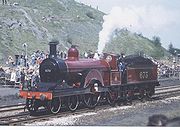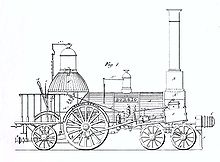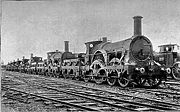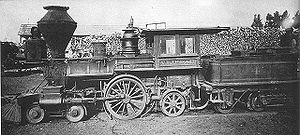
4-2-2
Encyclopedia

Whyte notation
The Whyte notation for classifying steam locomotives by wheel arrangement was devised by Frederick Methvan Whyte and came into use in the early twentieth century encouraged by an editorial in American Engineer and Railroad Journal...
for the classification of steam locomotive
Steam locomotive
A steam locomotive is a railway locomotive that produces its power through a steam engine. These locomotives are fueled by burning some combustible material, usually coal, wood or oil, to produce steam in a boiler, which drives the steam engine...
s, 4-2-2 represents the wheel arrangement
Wheel arrangement
In rail transport, a wheel arrangement is a system of classifying the way in which wheels are distributed beneath a locomotive.. Several notations exist to describe the wheel assemblies of a locomotive by type, position, and connections, with the adopted notations varying by country...
of four leading wheel
Leading wheel
The leading wheel or leading axle of a steam locomotive is an unpowered wheel or axle located in front of the driving wheels. The axle or axles of the leading wheels are normally located in a truck...
s on two axles, two powered driving wheel
Driving wheel
On a steam locomotive, a driving wheel is a powered wheel which is driven by the locomotive's pistons...
s on one axle, and two trailing wheel
Trailing wheel
On a steam locomotive, a trailing wheel or trailing axle is generally an unpowered wheel or axle located behind the driving wheels. The axle of the trailing wheels was usually located on a trailing truck...
s on one axle.
Other equivalent classifications are:
UIC classification
UIC classification
The UIC classification of locomotive axle arrangements describes the wheel arrangement of locomotives, multiple units and trams. It is set out in the International Union of Railways "Leaflet 650 - Standard designation of axle arrangement on locomotives and multiple-unit sets". It is used in much...
: 2A1 (also known as German classification and Italian classification)
French classification: 211
Turkish classification
Turkish classification
In the Turkish classification system for railway locomotives, the number of powered axles are followed by the total number of axles. It is identical to the Swiss system except that the latter places a slash between the two numbers.Thus0-6-0 becomes 33...
: 14
Swiss classification: 1/4
Like other steam locomotive types with single pairs of driving wheels, they were also known as singles.
History

Bogie
A bogie is a wheeled wagon or trolley. In mechanics terms, a bogie is a chassis or framework carrying wheels, attached to a vehicle. It can be fixed in place, as on a cargo truck, mounted on a swivel, as on a railway carriage/car or locomotive, or sprung as in the suspension of a caterpillar...
s, created a long rigid wheelbase
Wheelbase
In both road and rail vehicles, the wheelbase is the distance between the centers of the front and rear wheels.- Road :In automobiles, the wheelbase is the horizontal distance between the center of the front wheel and the center of the rear wheel...
with limited adhesion
Adhesion
Adhesion is any attraction process between dissimilar molecular species that can potentially bring them in close contact. By contrast, cohesion takes place between similar molecules....
. As a result, the type was relatively rare until the 1870s. The first steam locomotive made by Borsig of Berlin
Berlin
Berlin is the capital city of Germany and is one of the 16 states of Germany. With a population of 3.45 million people, Berlin is Germany's largest city. It is the second most populous city proper and the seventh most populous urban area in the European Union...
in 1841, the Borsig No 1, was an 4-2-2, but the company quickly reverted to the more common 2-2-2
2-2-2
Under the Whyte notation for the classification of steam locomotives, 2-2-2 represents the wheel arrangement of two leading wheels on one axle two powered driving wheels on one axle, and two trailing wheels on one axle. The wheel arrangement both provided more stability and enabled a larger firebox...
configuration.
UK developments
The London and North Western RailwayLondon and North Western Railway
The London and North Western Railway was a British railway company between 1846 and 1922. It was created by the merger of three companies – the Grand Junction Railway, the London and Birmingham Railway and the Manchester and Birmingham Railway...
No. 3020 Cornwall
LNWR 2-2-2 3020 Cornwall
London & North Western Railway 2-2-2 No. 3020 Cornwall is a preserved steam locomotive. She was built at Crewe in 1847. She was originally a 4-2-2 in 1847, but was extensively rebuilt, and converted to a 2-2-2 in 1858.- Early high-speed locomotive design :...
was built as 4-2-2 at Crewe in 1847, but was extensively rebuilt, and converted to a 2-2-2 in 1858.
Archibald Sturrock
Archibald Sturrock
Archibald Sturrock was a Scottish mechanical engineer who was locomotive superintendent of the Great Northern Railway from 1850 until c. 1866, having from 1840 been Daniel Gooch's assistant on the Great Western Railway....
of the Great Northern Railway
Great Northern Railway (Great Britain)
The Great Northern Railway was a British railway company established by the Great Northern Railway Act of 1846. On 1 January 1923 the company lost its identity as a constituent of the newly formed London and North Eastern Railway....
tried the configuration on one locomotive in 1853, but no further examples were built at that time.

Broad gauge
Broad-gauge railways use a track gauge greater than the standard gauge of .- List :For list see: List of broad gauges, by gauge and country- History :...
locomotives where sharp bends were less of an issue. Daniel Gooch
Daniel Gooch
Sir Daniel Gooch, 1st Baronet was an English railway and transatlantic cable engineer and Conservative politician who sat in the House of Commons from 1865 to 1885...
built 29 examples of his Iron Duke
GWR Iron Duke Class
The Great Western Railway Iron Duke Class 4-2-2 was a class of broad gauge steam locomotives for express passenger train work.-History:The prototype locomotive, Great Western, was built as a 2-2-2 locomotive in April 1846, but was soon converted to a 4-2-2 arrangement...
express locomotive class for the Great Western Railway
Great Western Railway
The Great Western Railway was a British railway company that linked London with the south-west and west of England and most of Wales. It was founded in 1833, received its enabling Act of Parliament in 1835 and ran its first trains in 1838...
between 1847 and 1855. They had an 8 ft diameter driving wheel
Driving wheel
On a steam locomotive, a driving wheel is a powered wheel which is driven by the locomotive's pistons...
size. Twenty examples of a similar design
Bristol and Exeter Railway 4-2-2 locomotives
The 20 Bristol and Exeter Railway 4-2-2 locomotives were broad gauge 4-2-2 express steam locomotives built for the Bristol and Exeter Railway by the Stothert and Slaughter in Bristol. The first entered service in 1849...
were built for the Bristol and Exeter Railway
Bristol and Exeter Railway
The Bristol & Exeter Railway was a railway company formed to connect Bristol and Exeter.The company's head office was situated outside their Bristol station...
after 1849, by Stothert and Slaughter
Avonside Engine Company
The Avonside Engine Company was a locomotive manufacturer in Avon Street, St. Philip's, Bristol, England between 1864 and 1934. However the business originated with an earlier enterprise Henry Stothert and Company.-Origins:...
in Bristol
Bristol
Bristol is a city, unitary authority area and ceremonial county in South West England, with an estimated population of 433,100 for the unitary authority in 2009, and a surrounding Larger Urban Zone with an estimated 1,070,000 residents in 2007...
. Because both sets of leading wheels are mounted independently in the frames in these classes, they are sometimes described as (2-2)-2-2 rather than 4-2-2.
By the 1870s, the use of bogies to give more flexibility, and steam sanding
Sandbox
Sandbox may refer to:* Litter box, an indoor box for cats to relieve themselves* Sandpit or sandbox, a wide, shallow playground construction to hold sand often made of wood or plastic...
to improve adhesion, enabled designers to create fast standard gauge express passenger locomotives of this type. On the Great Northern Railway
Great Northern Railway (Great Britain)
The Great Northern Railway was a British railway company established by the Great Northern Railway Act of 1846. On 1 January 1923 the company lost its identity as a constituent of the newly formed London and North Eastern Railway....
, Patrick Stirling
Patrick Stirling
Patrick Stirling was Locomotive Superintendent of the Great Northern Railway.His father Robert Stirling was also an engineer. His brother James Stirling was also a locomotive engineer...
built 53 examples
GNR Stirling 4-2-2
The Great Northern Railway No. 1 class Stirling Single is a class of steam locomotive designed for express passenger work. Designed by Patrick Stirling, they are characterised by a single pair of large driving wheels which led to the nickname "eight-footer"...
with outside cylinders at Doncaster railway works between 1870 and 1895, for use on the main line between London
London
London is the capital city of :England and the :United Kingdom, the largest metropolitan area in the United Kingdom, and the largest urban zone in the European Union by most measures. Located on the River Thames, London has been a major settlement for two millennia, its history going back to its...
and York
York
York is a walled city, situated at the confluence of the Rivers Ouse and Foss in North Yorkshire, England. The city has a rich heritage and has provided the backdrop to major political events throughout much of its two millennia of existence...
. They ran an average speed of more than 60 mph during the race to the north
Race to the North
The Race to the North is the name given to two summers in the late 19th century when British passenger trains belonging to different companies would literally race each other from London to Scotland over the two principal rail trunk routes connecting the English capital city to Scotland - the West...
, and were called eight-footers because of the driving wheel
Driving wheel
On a steam locomotive, a driving wheel is a powered wheel which is driven by the locomotive's pistons...
, that was more than 8 ft. in diameter. Stirling's successor Henry Ivatt
Henry Ivatt
Henry Alfred Ivatt was the Chief Mechanical Engineer of the Great Northern Railway from 1896 to 1911.- Biography :...
built a further twelve singles between 1898-1901 before moving on to larger 4-4-2
4-4-2 (locomotive)
Under the Whyte notation for the classification of steam locomotives, 4-4-2 represents the wheel arrangement of four leading wheels on two axles , four powered and coupled driving wheels on two axles, and two trailing wheels on one axle...
designs.
Following the success of the Great Northern designs, the Midland Railway
Midland Railway
The Midland Railway was a railway company in the United Kingdom from 1844 to 1922, when it became part of the London, Midland and Scottish Railway....
introduced the inside cylinder "Spinners". Eighty-five were built to five designs by Samuel W. Johnson
Samuel W. Johnson
Samuel Waite Johnson was Chief Mechanical Engineer of the Midland Railway from 1873 to 1903. He was born in Bramley, Yorkshire and educated at Leeds Grammar School.-Career:...
between 1887 and 1900. One 115 class
Midland Railway 115 Class
The Midland Railway 115 Class is a class of 4-2-2 steam locomotive. They were known as "Spinners", possibly because of the wheelslip that the single large driving wheel caused. They were designed by Samuel W...
, No. 673, survives at the National Railway Museum
National Railway Museum
The National Railway Museum is a museum in York forming part of the British National Museum of Science and Industry and telling the story of rail transport in Britain and its impact on society. It has won many awards, including the European Museum of the Year Award in 2001...
, York. William Dean of the Great Western built fifty examples of the standard gauge GWR 3031 Class
GWR 3031 Class
The Dean Single, 3031 Class, or Achilles Class was a type of steam locomotive built by the Great Western Railway between 1891 and 1899. They were designed by William Dean for passenger work...
Achilles class from 1893-1899. No 3065 Duke of Connaught made a record-breaking run with the Ocean Mail express train on 9 May 1904, covering the distance from Plymouth to Paddington in 227 minutes.
Other notable UK examples are the unique Caledonian Railway
Caledonian Railway
The Caledonian Railway was a major Scottish railway company. It was formed in the early 19th century and it was absorbed almost a century later into the London, Midland and Scottish Railway, in the 1923 railway grouping, by means of the Railways Act 1921...
single
Caledonian Railway Single
Caledonian Railway Single No. 123 is a preserved Scottish steam locomotive. The unique 4-2-2 was built by Neilson and Company in 1886, works No. 3553 as an exhibition locomotive. In 1914 it was placed on the Caledonian Railway duplicate list, and renumbered 1123...
No.123, which has been preserved, and the GER Class P43
GER Class P43
The GER Class P43 was a class of ten 4-2-2 steam tender locomotives designed by James Holden for the Great Eastern Railway. They were the last 'singles' built for the Great Eastern, and the last in service.-History:...
, which was an early oil
Oil
An oil is any substance that is liquid at ambient temperatures and does not mix with water but may mix with other oils and organic solvents. This general definition includes vegetable oils, volatile essential oils, petrochemical oils, and synthetic oils....
-burning engine, developed by the pioneer of oil
Oil
An oil is any substance that is liquid at ambient temperatures and does not mix with water but may mix with other oils and organic solvents. This general definition includes vegetable oils, volatile essential oils, petrochemical oils, and synthetic oils....
-boilers, James Holden
James Holden (engineer)
James Holden was an English locomotive engineer.He is remembered mainly for the "Claud Hamilton" 4-4-0, his pioneering work with oil fuel, and his unique "Decapod".- Biography :...
US developments

Central Pacific Railroad
The Central Pacific Railroad is the former name of the railroad network built between California and Utah, USA that formed part of the "First Transcontinental Railroad" in North America. It is now part of the Union Pacific Railroad. Many 19th century national proposals to build a transcontinental...
and in 1872 was rebuilt as a 4-2-2.
By 1900 typical loads on express trains had grown beyond the capabilities of 4-2-2 locomotives and the configuration was superseded by the 4-4-2
4-4-2 (locomotive)
Under the Whyte notation for the classification of steam locomotives, 4-4-2 represents the wheel arrangement of four leading wheels on two axles , four powered and coupled driving wheels on two axles, and two trailing wheels on one axle...
.

